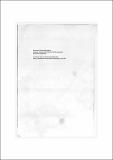| dc.contributor.author | Raikes, Philip L. | |
| dc.date.accessioned | 2011-12-14T16:10:38Z | |
| dc.date.available | 2011-12-14T16:10:38Z | |
| dc.date.issued | 1989-03 | |
| dc.identifier.citation | Raikes, Philip L. (1989) Credit and savings in rural Kenya: an example from Kisii. Working paper no. 466, Nairobi: Institute for Development Studies, University of Nairobi | en_GB |
| dc.identifier.uri | https://opendocs.ids.ac.uk/opendocs/handle/20.500.12413/1324 | |
| dc.description.abstract | Academic and professional writing on rural credit in Africa and Kenya focuses almost solely on lending through state or donor-funded institutions. A precise of much of this literature is that credit programmes are needed because lack of credit inhibits agricultural modernization. This paper questions every aspect of this statement. Firstly it is unclear how much of this “rural credit” even increases the funds available to agriculture; when combined with investors' own funds, it may have the opposite effect. Secondly, it is still less clear that the effects of such programmes are positive, especially for poorer peasant farmers. Direct effects are hard to assess, since they are over-shadowed by weightier factors affecting crop production, like international price trends and the impact of marketing agencies. But "development credit" has had its own negative effect on marketing, through increasing the indebtedness of co-operatives, which then lower prices or provide poorer services to their members.
The main aim of the paper is to show the falsity of the underlying precise; the lack of local credit. In the area studied, a wide variety of mechanisms for borrowing, lending and saving accounts for a far large volume of transactions than donor-funded programmes, even at their late-1970s peak. Much of this is short—term credit, at interest—rates which are often too high for investment in production (as opposed to trading). But this reflects, as much as it directs, the structure of investment opportunities. It is certainly not a lack of credit. Nor is it "just" consumer credit, though one can doubt the usefulness of that distinction, when peasant fern and household or so intimately linked that transactions in one sphere must affect those in the other(s). The combination of formal and informal rural banking structures and mechanisms, which is emerging, seems increasingly capable of meeting the needs of those normally served by such structures. But it seems to offer little to the poorest rural strata except the prospect of indebtedness and quite possibly consequential loss of land. | en_GB |
| dc.language.iso | en | en_GB |
| dc.publisher | Institute for Development Studies, University of Nairobi | en_GB |
| dc.relation.ispartofseries | Working Papers.;466 | |
| dc.rights.uri | http://creativecommons.org/licenses/by-nc-nd/3.0/ | en_GB |
| dc.subject | Finance | en_GB |
| dc.subject | Rural Development | en_GB |
| dc.title | Credit and savings in rural Kenya: an example from Kisii | en_GB |
| dc.type | Series paper (non-IDS) | en_GB |
| dc.rights.holder | Institute for Development Studies, University of Nairobi | en_GB |
| dc.identifier.blds | 45946 | |


